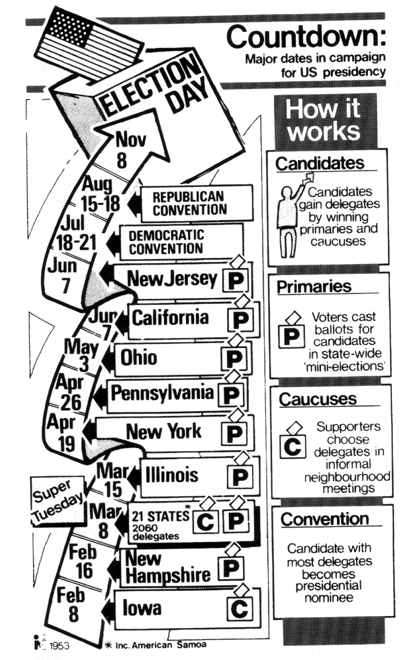In simplest outline, how is a President chosen? First, a candidate
campaigns within his party for nomination at a national convention. After the
convention comes a period of competition with the nominee of the other major
party and perhaps those of minor parties. The showdown comes on Election Day.
The candidate must win more popular votes than any other nominee in enough
states and the District of Columbia to give him a majority of the electoral
votes. If he does all those things, he has won the right to the office of
President of the United States.
When does a candidate begin to campaign? These days, a candidate will
begin to travel extensively around the country, discussing issues and making
contacts, two to three years before Election Day. He keeps in touch with party
leaders in many regions and visits more and more frequently the politically most
important states -the large ones and those that choose convention delegates
early. His supporters raise money for campaign expenses.
How are delegates to a national convention chosen? Some are elected by
voters in state primary contests. In other states, they are chosen in
conventions or caucuses. The number of delegate seats a party allots to a state
is determined to some degree by population, plus how well the state supported
the party's candidates in past elections.
 |
How does a state primary
work? Rules for primaries vary from state to state and party to party.
In general, voters may elect delegates either directly or by showing a
preference for a presidential candidate.
Are some primaries more important than others? Yes. Victors in the
early primaries get a psychological lift. They may be able to attract
fence-sitters to their side and also find it easier to raise money.
Just how does a national presidential-nominating convention work? It is
a large meeting within a political party made up of delegates chosen in
the states, the District of Columbia and U.S. territories or possessions.
The conventions meet every presidential-election year and pick the
parties' presidential and vice-presidential nominees. In both major
parties, a simple majority of delegate votes is enough to win the
nomination.
Once the conventions are over, what are the next steps? First, the
Republican and Democratic nominees meet with their advisers to map
strategy. Each side decides which states will be pivotal and plots a
campaign that concentrates on those states.
At the same time, the presidential and vice-presidential nominees are
crisscrossing the country by plane.
The major labor unions and big-city political organizations generally
fall into line behind the Democratic ticket. Republicans can count on the
backing of much of business and industry. Democrats will stress party
loyalty and voter registration. Since there are many more registered
Democrats than Republicans, GOP campaigners will try to identify issues
that appeal to the large and growing number of independent voters.
How is Election Day established?
Federal law places it on the Tuesday following the first Monday in
November, in the fourth year after the previous election of a President. |
Is the President actually elected on that day? Strictly speaking, no. It
is the presidential electors, popularly known as the Electoral College, who are
elected then. However, except in rare cases it is easy to translate the
nationwide popular vote into electoral votes. Thus, almost always, the next
President is known late on Election Day.
Do the presidential electors vote by states? It is a winner-take-all
proposition. In general, a state's whole slate of victorious electors votes for
the presidential nominee who gets the most popular votes in that state.
Could a candidate win more popular votes in November than an opponent and
still lose the election? Yes. That is because the electors vote by states.
Assume this situation: The Democratic candidate carries some of the heavily
populated states overwhelmingly, but loses other populous states by narrow
margins. It then would be possible for the Democrat to have more popular votes
than the Republican nominee and yet not net enough electoral votes to win.

